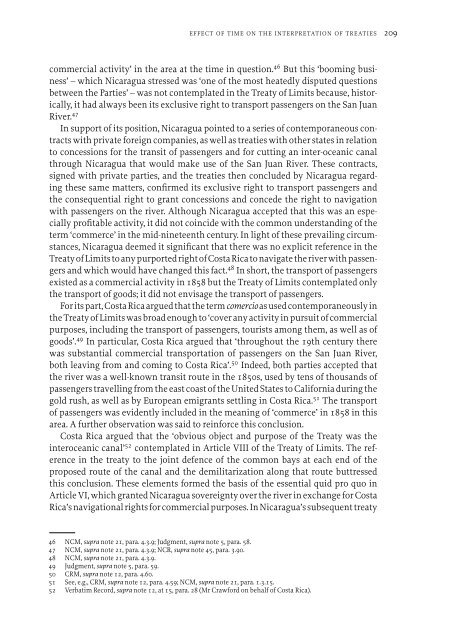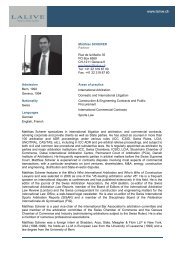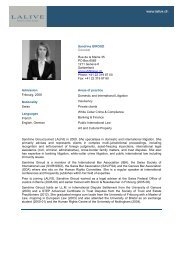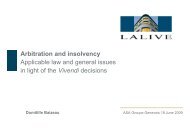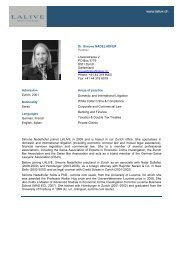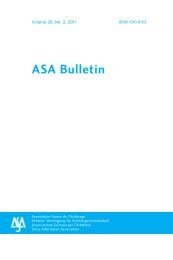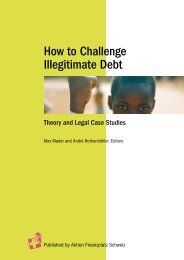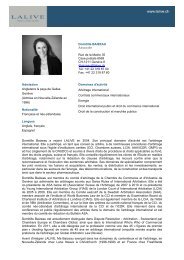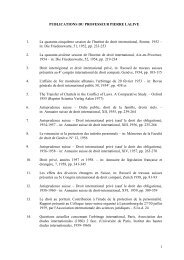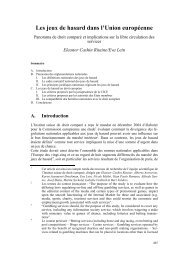The Effect of the Passage of Time on the Interpretation of Treaties ...
The Effect of the Passage of Time on the Interpretation of Treaties ...
The Effect of the Passage of Time on the Interpretation of Treaties ...
Create successful ePaper yourself
Turn your PDF publications into a flip-book with our unique Google optimized e-Paper software.
EFFECT OF TIME ON THE INTERPRETATION OF TREATIES 209<br />
commercial activity’ in <str<strong>on</strong>g>the</str<strong>on</strong>g> area at <str<strong>on</strong>g>the</str<strong>on</strong>g> time in questi<strong>on</strong>. 46 But this ‘booming business’<br />
– which Nicaragua stressed was ‘<strong>on</strong>e <str<strong>on</strong>g>of</str<strong>on</strong>g> <str<strong>on</strong>g>the</str<strong>on</strong>g> most heatedly disputed questi<strong>on</strong>s<br />
between <str<strong>on</strong>g>the</str<strong>on</strong>g> Parties’ – was not c<strong>on</strong>templated in <str<strong>on</strong>g>the</str<strong>on</strong>g> Treaty <str<strong>on</strong>g>of</str<strong>on</strong>g> Limits because, historically,<br />
it had always been its exclusive right to transport passengers <strong>on</strong> <str<strong>on</strong>g>the</str<strong>on</strong>g> San Juan<br />
River. 47<br />
In support <str<strong>on</strong>g>of</str<strong>on</strong>g> its positi<strong>on</strong>, Nicaragua pointed to a series <str<strong>on</strong>g>of</str<strong>on</strong>g> c<strong>on</strong>temporaneous c<strong>on</strong>tracts<br />
with private foreign companies, as well as treaties with o<str<strong>on</strong>g>the</str<strong>on</strong>g>r states in relati<strong>on</strong><br />
to c<strong>on</strong>cessi<strong>on</strong>s for <str<strong>on</strong>g>the</str<strong>on</strong>g> transit <str<strong>on</strong>g>of</str<strong>on</strong>g> passengers and for cutting an inter-oceanic canal<br />
through Nicaragua that would make use <str<strong>on</strong>g>of</str<strong>on</strong>g> <str<strong>on</strong>g>the</str<strong>on</strong>g> San Juan River. <str<strong>on</strong>g>The</str<strong>on</strong>g>se c<strong>on</strong>tracts,<br />
signed with private parties, and <str<strong>on</strong>g>the</str<strong>on</strong>g> treaties <str<strong>on</strong>g>the</str<strong>on</strong>g>n c<strong>on</strong>cluded by Nicaragua regarding<br />
<str<strong>on</strong>g>the</str<strong>on</strong>g>se same matters, c<strong>on</strong>firmed its exclusive right to transport passengers and<br />
<str<strong>on</strong>g>the</str<strong>on</strong>g> c<strong>on</strong>sequential right to grant c<strong>on</strong>cessi<strong>on</strong>s and c<strong>on</strong>cede <str<strong>on</strong>g>the</str<strong>on</strong>g> right to navigati<strong>on</strong><br />
with passengers <strong>on</strong> <str<strong>on</strong>g>the</str<strong>on</strong>g> river. Although Nicaragua accepted that this was an especially<br />
pr<str<strong>on</strong>g>of</str<strong>on</strong>g>itable activity, it did not coincide with <str<strong>on</strong>g>the</str<strong>on</strong>g> comm<strong>on</strong> understanding <str<strong>on</strong>g>of</str<strong>on</strong>g> <str<strong>on</strong>g>the</str<strong>on</strong>g><br />
term ‘commerce’ in <str<strong>on</strong>g>the</str<strong>on</strong>g> mid-nineteenth century. In light <str<strong>on</strong>g>of</str<strong>on</strong>g> <str<strong>on</strong>g>the</str<strong>on</strong>g>se prevailing circumstances,<br />
Nicaragua deemed it significant that <str<strong>on</strong>g>the</str<strong>on</strong>g>re was no explicit reference in <str<strong>on</strong>g>the</str<strong>on</strong>g><br />
Treaty<str<strong>on</strong>g>of</str<strong>on</strong>g>Limitstoanypurportedright<str<strong>on</strong>g>of</str<strong>on</strong>g>CostaRicat<strong>on</strong>avigate<str<strong>on</strong>g>the</str<strong>on</strong>g>riverwithpassengers<br />
and which would have changed this fact. 48 In short, <str<strong>on</strong>g>the</str<strong>on</strong>g> transport <str<strong>on</strong>g>of</str<strong>on</strong>g> passengers<br />
existed as a commercial activity in 1858 but <str<strong>on</strong>g>the</str<strong>on</strong>g> Treaty <str<strong>on</strong>g>of</str<strong>on</strong>g> Limits c<strong>on</strong>templated <strong>on</strong>ly<br />
<str<strong>on</strong>g>the</str<strong>on</strong>g> transport <str<strong>on</strong>g>of</str<strong>on</strong>g> goods; it did not envisage <str<strong>on</strong>g>the</str<strong>on</strong>g> transport <str<strong>on</strong>g>of</str<strong>on</strong>g> passengers.<br />
Foritspart,CostaRicaarguedthat<str<strong>on</strong>g>the</str<strong>on</strong>g>termcomercioasusedc<strong>on</strong>temporaneouslyin<br />
<str<strong>on</strong>g>the</str<strong>on</strong>g> Treaty <str<strong>on</strong>g>of</str<strong>on</strong>g> Limits was broad enough to ‘cover any activity in pursuit <str<strong>on</strong>g>of</str<strong>on</strong>g> commercial<br />
purposes, including <str<strong>on</strong>g>the</str<strong>on</strong>g> transport <str<strong>on</strong>g>of</str<strong>on</strong>g> passengers, tourists am<strong>on</strong>g <str<strong>on</strong>g>the</str<strong>on</strong>g>m, as well as <str<strong>on</strong>g>of</str<strong>on</strong>g><br />
goods’. 49 In particular, Costa Rica argued that ‘throughout <str<strong>on</strong>g>the</str<strong>on</strong>g> 19th century <str<strong>on</strong>g>the</str<strong>on</strong>g>re<br />
was substantial commercial transportati<strong>on</strong> <str<strong>on</strong>g>of</str<strong>on</strong>g> passengers <strong>on</strong> <str<strong>on</strong>g>the</str<strong>on</strong>g> San Juan River,<br />
both leaving from and coming to Costa Rica’. 50 Indeed, both parties accepted that<br />
<str<strong>on</strong>g>the</str<strong>on</strong>g> river was a well-known transit route in <str<strong>on</strong>g>the</str<strong>on</strong>g> 1850s, used by tens <str<strong>on</strong>g>of</str<strong>on</strong>g> thousands <str<strong>on</strong>g>of</str<strong>on</strong>g><br />
passengers travelling from <str<strong>on</strong>g>the</str<strong>on</strong>g> east coast <str<strong>on</strong>g>of</str<strong>on</strong>g> <str<strong>on</strong>g>the</str<strong>on</strong>g> United States to California during <str<strong>on</strong>g>the</str<strong>on</strong>g><br />
gold rush, as well as by European emigrants settling in Costa Rica. 51 <str<strong>on</strong>g>The</str<strong>on</strong>g> transport<br />
<str<strong>on</strong>g>of</str<strong>on</strong>g> passengers was evidently included in <str<strong>on</strong>g>the</str<strong>on</strong>g> meaning <str<strong>on</strong>g>of</str<strong>on</strong>g> ‘commerce’ in 1858 in this<br />
area. A fur<str<strong>on</strong>g>the</str<strong>on</strong>g>r observati<strong>on</strong> was said to reinforce this c<strong>on</strong>clusi<strong>on</strong>.<br />
Costa Rica argued that <str<strong>on</strong>g>the</str<strong>on</strong>g> ‘obvious object and purpose <str<strong>on</strong>g>of</str<strong>on</strong>g> <str<strong>on</strong>g>the</str<strong>on</strong>g> Treaty was <str<strong>on</strong>g>the</str<strong>on</strong>g><br />
interoceanic canal’ 52 c<strong>on</strong>templated in Article VIII <str<strong>on</strong>g>of</str<strong>on</strong>g> <str<strong>on</strong>g>the</str<strong>on</strong>g> Treaty <str<strong>on</strong>g>of</str<strong>on</strong>g> Limits. <str<strong>on</strong>g>The</str<strong>on</strong>g> reference<br />
in <str<strong>on</strong>g>the</str<strong>on</strong>g> treaty to <str<strong>on</strong>g>the</str<strong>on</strong>g> joint defence <str<strong>on</strong>g>of</str<strong>on</strong>g> <str<strong>on</strong>g>the</str<strong>on</strong>g> comm<strong>on</strong> bays at each end <str<strong>on</strong>g>of</str<strong>on</strong>g> <str<strong>on</strong>g>the</str<strong>on</strong>g><br />
proposed route <str<strong>on</strong>g>of</str<strong>on</strong>g> <str<strong>on</strong>g>the</str<strong>on</strong>g> canal and <str<strong>on</strong>g>the</str<strong>on</strong>g> demilitarizati<strong>on</strong> al<strong>on</strong>g that route buttressed<br />
this c<strong>on</strong>clusi<strong>on</strong>. <str<strong>on</strong>g>The</str<strong>on</strong>g>se elements formed <str<strong>on</strong>g>the</str<strong>on</strong>g> basis <str<strong>on</strong>g>of</str<strong>on</strong>g> <str<strong>on</strong>g>the</str<strong>on</strong>g> essential quid pro quo in<br />
Article VI, which granted Nicaragua sovereignty over <str<strong>on</strong>g>the</str<strong>on</strong>g> river in exchange for Costa<br />
Rica’snavigati<strong>on</strong>alrightsfor commercialpurposes.InNicaragua’ssubsequenttreaty<br />
46 NCM, supra note 21, para. 4.3.9; Judgment, supra note 5, para. 58.<br />
47 NCM, supra note 21, para. 4.3.9; NCR, supra note 45, para. 3.90.<br />
48 NCM, supra note 21, para. 4.3.9.<br />
49 Judgment, supra note 5, para. 59.<br />
50 CRM, supra note 12, para. 4.60.<br />
51 See, e.g., CRM, supra note 12, para. 4.59; NCM, supra note 21, para. 1.3.15.<br />
52 Verbatim Record, supra note 12, at 15, para. 28 (Mr Crawford <strong>on</strong> behalf <str<strong>on</strong>g>of</str<strong>on</strong>g> Costa Rica).


